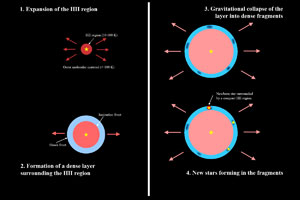How do massive stars form? A case of triggered high-mass stars formation

The collect and collapse process: a way of triggering the formation of massive stars.
In an upcoming issue, the journal Astronomy & Astrophysics will publish the most complete picture of a “triggered” star-forming region. Induced (or “triggered”) star formation is one of the processes that are supposed to lead to the formation of massive stars. Massive stars play a key role in the chemical and dynamical evolution of galaxies. The way massive stars form is still much debated among the astronomers’ community: it is currently one of the hottest astrophysical topics. Do they form by accretion as low-mass stars do or do they need the environment of a dense cluster to form through the merging of low mass protostars?
In this framework, the team led by Annie Zavagno and Lise Deharveng (from the Laboratoire d’Astrophysique de Marseille, France) selected regions where several generations of massive stars are likely to be formed. Stars more massive than 8 solar masses, once formed, emit intense UV photons that ionize the surrounding gas. The region filled with ionized hydrogen is called an HII region. Theory suggests that the expansion of the HII region can trigger massive star formation: after the HII region has formed, it expands continuously because the temperature inside the region is much higher than in the cold environment that surrounds it. During the expansion, a dense layer of gas and dust is collected around the HII region, after which gravitational instabilities in the layer cause it to fragment into dense clumps, which then go on to collapse into new stars. The fragments are massive and thus form massive objects (stars or clusters). The successive steps of this process, called collect and collapse process, are shown in Figure 1.
To characterize this process, the team selected the Galactic HII region RCW 79, located 14000 light-years from the Earth. They combined observational data obtained at different wavelengths, as well as from various origins (space, ground-based telescopes, and archived observations), to probe different parts of the region, as illustrated in Figure 2.
The orange image was obtained in the infrared range with NASA’s Spitzer Space Telescope: it depicts with high precision the dust shell that surrounds the HII region RCW 79. The blue part of the image corresponds to the Ha emission line that probes the ionized hydrogen (observations from the SuperCOSMOS Sky Survey): clearly, the shell is filled in by ionized hydrogen. The team then obtained their own set of observations to elucidate the complete picture of the star-forming region. The yellow contours correspond to observations obtained at millimeter wavelengths with the ESO Swedish Submillimetre Telescope (SEST). These contours depict cold dust condensations in the shell structure. The team has identified the newly-formed stars associated with these condensations, using mid-infrared Spitzer observations from the GLIMPSE survey. They find that second-generation massive stars (with mass higher than 8 solar masses) are associated with the main condensations. One of these condensations was observed at near-infrared wavelengths with the ESO-New Technology Telescope (see insert in Figure 2). It includes a massive star that is evolved enough to emit high-energy photons and to give rise to a compact HII region. This compact HII region is thus a second-generation HII region.
The locations of all the structures that were picked out at various wavelengths agree very well with the predictions of the collect and collapse process. The conclusions drawn by the team largely rely on the morphological relations between these structures. The combined picture of RCW 79 they obtained is therefore a straightforward illustration of the triggered massive-star formation process that now occurs in this region. These observations show that the collect and collapse process is the main triggering agent of massive star formation observed on the borders of this region.
Media Contact
All latest news from the category: Physics and Astronomy
This area deals with the fundamental laws and building blocks of nature and how they interact, the properties and the behavior of matter, and research into space and time and their structures.
innovations-report provides in-depth reports and articles on subjects such as astrophysics, laser technologies, nuclear, quantum, particle and solid-state physics, nanotechnologies, planetary research and findings (Mars, Venus) and developments related to the Hubble Telescope.
Newest articles

Superradiant atoms could push the boundaries of how precisely time can be measured
Superradiant atoms can help us measure time more precisely than ever. In a new study, researchers from the University of Copenhagen present a new method for measuring the time interval,…

Ion thermoelectric conversion devices for near room temperature
The electrode sheet of the thermoelectric device consists of ionic hydrogel, which is sandwiched between the electrodes to form, and the Prussian blue on the electrode undergoes a redox reaction…

Zap Energy achieves 37-million-degree temperatures in a compact device
New publication reports record electron temperatures for a small-scale, sheared-flow-stabilized Z-pinch fusion device. In the nine decades since humans first produced fusion reactions, only a few fusion technologies have demonstrated…





















